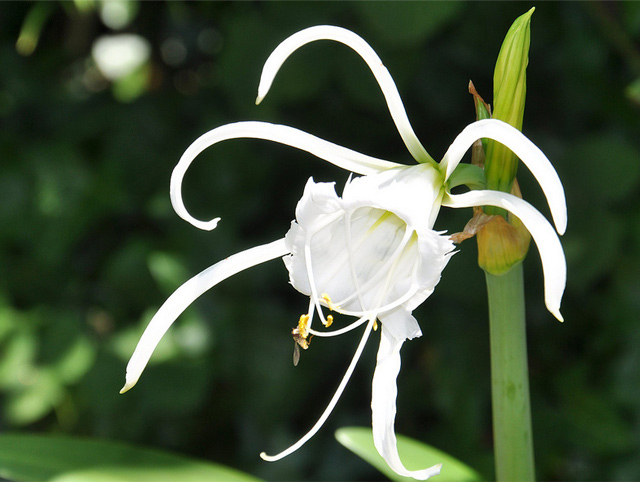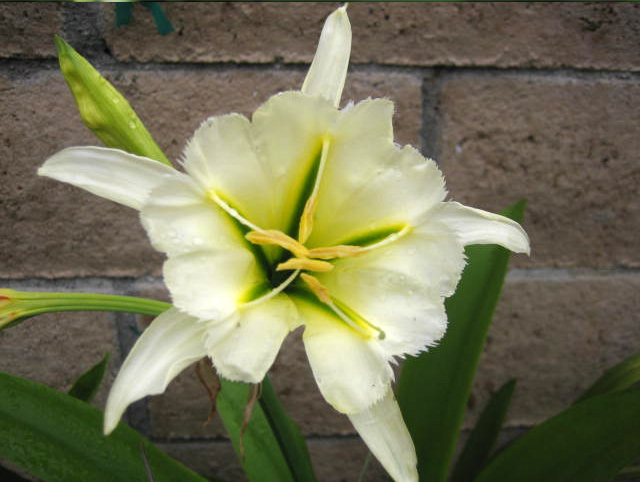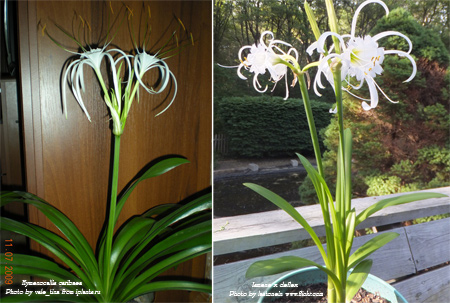Amaryllis family. Homeland - South America, mainly Peru and Ecuador. 10 species and one hybrid are common in nature. You will not find species Ismene in Russia, but the hybrid is of interest to us. This is Ismene bent Ismene x deflexa - a synonym for Ismene x festalis or earlier Hymenocallis x festalis Hymenocallis festive (early). It is Ismene bent that is most common as a houseplant, greenhouse and garden plant.
It was obtained by crossing Ismene long-petalled Ismene longipetala and Ismene narcissiflora Ismene daffodil.
It is a deciduous perennial bulbous plant. The bulb is ovoid, on average 10-12 cm in diameter, thin light brown cover scales. The leaves are belt-shaped, dark green, 50-60 cm long and about 7-10 cm wide, and form an erect false stem. It is the formation of a pseudostem that distinguishes representatives of the Ismene clan from the Gimenokallis.
 Ismene x deflexa Photo by Jean-Michel Moullec flickr.com
Ismene x deflexa Photo by Jean-Michel Moullec flickr.comPeduncle single, leafless, about 40-45 cm long, umbrella-shaped inflorescence of 3-6 flowers. Perianths at the base form a crown (fused with the lower parts of the stamens, between them a thin membrane) with a diameter of about 5 cm. The crown is white, large, wide, with a fringed edge. Six petals are slightly wrapped spirally. Anthers are yellow-orange. The flowers are very fragrant. Based on this hybrid and other species, breeding work is underway, the Zwanenburg Zwanenburg variety has been bred, which is distinguished by a larger bush size (about 80-90 cm high) and larger flowers - the crown in diameter reaches 8-10 cm. Ismene bent is not capable of seed reproduction (the flowers are sterile). Flowering from about May-June for two weeks.
 Ismene spofforthiae 'Sulphur Queen' Photo by Erick Lux flickr.com
Ismene spofforthiae 'Sulphur Queen' Photo by Erick Lux flickr.comAnother popular hybrid seen in Ismene hybrids' Sulphur Queen'sale Ismene Sulphur Queen is an interspecific hybrid from the interbreeding of Peruvian species Ismene amancae and Ismene narcissiflora. It has a pronounced pseudostem, the height of the bush is up to 60 cm. Very spectacular fragrant flowers, similar to daffodil flowers: yellow (canary) petals, the crown is yellow on the inside, with green stripes along the lower part of the stamens. From the moment of blooming, the color of the flower brightens and by noon becomes white, only inside the crown, yellowness remains around the green stripes of stamen threads. This hybrid appears in European forums and markets under the names Golden Peruvian Daffodil Golden Peruvian Narcissus and Sacred Inca Lily Sacred Lily Inca.
This interspecific hybrid was first described by the English botanist William Herbert in 1837 as Ismene x spofforthiae. But this name is not official, in addition, initially the interspecies hybrid did not have much effect. The Dutch floriculture company CG van Tubergen, founded in 1868 by the Van Tubergen brothers and engaged in the sale of bulbs and seeds (still engaged to this day), began experiments on crossing Ismene species, and received several beautiful varieties, one of which is Sulfur Queen still conquers the world.
The difference between Ismene and Gimenokallis: the first obvious sign is the presence of a pseudostem in Ismene, moreover, it becomes noticeable even in a very young plant. In Hymenokallis, the leaves always grow in a rosette. In addition, there are other differences that can be found at the time of flowering: in Ismene, the bases of the stamen filaments inside the calyx are always painted greenish, in species Gimenokallis never. In Ismene, flowers in inflorescences look to the sides and even down (Ismene hawkesii), i.e. pedicels deviate from the peduncle axis horizontally. In Gimenocallis, the flowers in the inflorescence are directed upward, i.e. pedicels in a bunch:
Caring for ismen
Temperature
During the growing season, the optimal temperature is 20-22 ° C, Ismen do not like heat, so it is better to shade flowering bushes at temperatures above 26-28 ° C. During the rest period, Ismene bulbs are stored at 12-14 ° C (at least 10 ° C), dry, in the same pots that they were grown. It is permissible to dig up bulbs and store them in smaller pots or boxes in sawdust, but you cannot touch the roots (cut or cut). Storage at a higher temperature disrupts the dormant period and the bulbs may begin to germinate ahead of time. In March, Ismene can be transplanted into fresh ground, trying not to injure the roots. 2-3 days after transplantation, watering can be resumed.
If Ismen is planned to be grown as a garden plant, then at the end of March the bulbs are moved to warmer conditions - optimally 18-20 ° C (not higher), and left until they leave rest on their own. They are planted in the ground in early May, mixing well-rotted compost into the ground. It is impossible to water the onion itself, if the soil is too dry, then before planting you need to thoroughly spill the hole, then pour a layer of dry sand or sawdust and plant it, sprinkling it with dry earth 2-3 cm above the onion. After flowering, the peduncle must be trimmed. And from the second half of September, if the bulb has grown, even before the onset of frost, Ismen can be dug up for storage, even if the leaves have not begun to turn yellow. If the onions have not grown enough, you can wait until the first frost. Dig carefully so as not to damage juicy roots. Do not break off the children formed over the summer with Ismene (we postpone reproduction until spring). Dust off the soil as much as it falls off (do not shake much). Put on the side of the drying on the lattice or mesh - the earth from the roots will dry and crumble. The leaves themselves begin to turn yellow and dry out. In about two weeks, the bulbs are ready to go into storage - dry leaves can be cut off.
Lighting
Ismen are very photophilous, they need a sunny place of southern orientation, but at the same time in the hottest hours they need a slight shade. From about 12 to 15 o'clock it is better to cover the windows with a mosquito net. It is very difficult for Ismene, not just from the scorching sun, but from the stuffiness and heat. Therefore, do not forget to keep the windows open. If there is not enough light, the Ismene bush stretches, the pseudostem becomes indecently long, and slopes towards the light, the leaves are whip-like, pale or yellowish, flowering is scarce. If this happens, it is more humane to plant a plant in a garden, in a sunny place protected from the wind. For example, on the leeward side of fruit shrubs.
Watering
Watering is plentiful during the growing season - the soil should be slightly moist inside the pot all the time. I.e. you need to water as soon as the top layer of the earth dries. During the rest period, watering is very limited, depending on the storage temperature. If at a temperature of 15-17 ° C - approximately 1 times every 5-6 weeks in a little, at a lower temperature of 8-10 degrees we do without watering.
Air humidity: Ismene is resistant to dry air, does not need spraying.
Fertilizer
Ismene is fed with special fertilizer for bulbous plants, diluted in the concentration recommended by the manufacturer. Feeding begins as soon as young leaves appear, and ends when the plant fades. At the beginning of growth, feeding with organic matter diluted in a lower concentration than for ordinary flowers is possible. During flowering and after its end, it is impossible to feed with organic matter, the bulbs should ripen and prepare for the next period of rest.
Flight connections
Soil for growing ismene: from a mixture of 2 parts of turf, 1 part of sheet earth, 1 part of humus and 1 part of sand or vermiculite. pH acidity is close to neutral. Pots are usually large, 5-7 liters, drainage and large holes for water runoff are desirable to the bottom. When transplanting, Ismen bulbs are buried with earth, deepening by 3-5 cm. If the onion is exposed over time, it should be mulched with fresh earth.
When planting Ismene in the garden, there are no special requirements for soils - these plants only do not like strongly alkaline and strongly acidic soils. Ismen are vigorous plants, they build up green mass well and quickly with the beginning of vegetation, so well-rotted compost is added to the pit when planting. But since bulbs are very sensitive to waterlogging, the soil should be very air-intensive. To do this, you can add sand, vermiculite, bark, straw, anything, so as not to form a dense adhered layer of earth after rains.
Reproduction
Ismene is propagated by daughter bulbs during transplantation. Ismen bent detkes well, sometimes to the detriment of flowering, seeds do not reproduce. It has been noticed that bulbs located close to the surface of the earth are more prone to detoxification, so sometimes it is advisable to bury the bulbs deeper, but monitor the condition of the soil - it should not be waterlogged. Bows rot from increased soil moisture.
Diseases and pests
Ismen can infect aphids, thrips, whiteflies, do not disdain this plant, especially in indoor conditions, shields and whiteflies. There is only one measure against all pests: the removal of colonies, larvae and pest secretions with an alcohol solution using a cotton swab, watering with actara or confidor.
Ismene bulbs, like any others, can be damaged by rot from excess moisture in the soil if the weather is too rainy, when frequent watering or heavy clay soil.
